A Grandmaster Of Tradition And Innovation
By Ivan MaiselJack Swarbrick is a thinker.
As a member of an academic community, Swarbrick is among his people. The campus of the University of Notre Dame is filled with men and women who spend much of the day in the zip code of their own head. The campus is, if not a safe haven, a place where deep thinkers are sheltered from the thrust and parry of the business world.
Except that Swarbrick served for 16 years as University Vice President and James E. Rohr Director of Athletics, a campus job with pilings sunk deeply in commerce. He ran a front-porch business with a nine-figure budget. He served as the custodian of a tradition that the university holds more dearly than anything outside of the Catholic Church. He undertook a job that requires an executive willing to make big decisions, and willing to be accountable if he makes the wrong one.
Swarbrick didn’t make the wrong one very often.
Now that Swarbrick has stepped aside and put the athletic department in the hands of Pete Bevacqua, there is an argument to be had over the grandest achievement of Swarbrick’s tenure at Notre Dame. His sense for melding tradition and progress can be seen in the Campus Crossroads project, which managed to upgrade Notre Dame Stadium and add 800,000 square feet of classrooms, student activity and hospitality space while looking as if it has been in place for a generation.
His eye for coaching talent is evident in the 10 national championships that the Fighting Irish won in five different sports during his tenure. Swarbrick kept the values and integrity of the university in the forefront of his thinking on every decision he made, but the university’s voice carries farther when it wins. “You only have the platform if you’re good enough to have it,” Swarbrick said. “It doesn’t do any good to be value-based and not win games.”
But to see the most lasting contribution that Swarbrick made to his alma mater, all you have to do is look around. In a time of unprecedented turmoil in intercollegiate athletics, as the evolution of the arms race and the chase for media dollars triggered universities to abandon traditional partners and caused an entire conference to vaporize, Notre Dame not only maintained its independence in football but strengthened it.
“You only have the platform if you’re good enough to have it. It doesn’t do any good to be value-based and not win games.”
“This place is different,” Swarbrick said, “and what recent times have delivered to us is the ability, the opportunity to really stress that difference. I tell our coaches all the time, double down on our distinctiveness. Don’t try to go with the flow, because stressing our distinctiveness will separate us in a way that will benefit you more than trying to keep up with the Joneses. And I believe that it does.”
The university continues to be an athletic unicorn, in large part because the man who steered it through the treacherous waters of conference-hopping, COVID, and NIL payments is a unicorn, too. He wasn’t a coach. He didn’t come to his job through fundraising, or by working his way up the assistant AD ladder.
National Championships Under Jack Swarbrick
| Sport | Year | Coach |
|---|---|---|
| Women's Soccer | 2010 | Randy Waldrum |
| Fencing | 2011 | Janusz Bednarski |
| Men's Soccer | 2013 | Bobby Clark |
| Fencing | 2017 | Guiorgie "Gia" Kvaratskhelia |
| Fencing | 2018 | Guiorgie "Gia" Kvaratskhelia |
| Women's Basketball | 2018 | Muffet McGraw |
| Fencing | 2021 | Guiorgie "Gia" Kvaratskhelia |
| Fencing | 2022 | Guiorgie "Gia" Kvaratskhelia |
| Fencing | 2023 | Guiorgie "Gia" Kvaratskhelia |
| Men's Lacrosse | 2023 | Kevin Corrigan |
“What Jack brought to the table was thinking differently,” said Jack Brennan, who in June concluded nine years as chair of the University Board of Trustees. The men and women who worked with and for Swarbrick describe his ability “to see around the corner,” a talent usually ascribed to a grandmaster seeing the next five moves on the chessboard. Swarbrick credited his legal training – “You learn in law school to start with your closing argument and work backward” – but there must be more to it than that. There are 35,000 law school graduates a year and very few grandmasters.
Deputy athletics director Ron Powlus, in a department tribute to Jack, wrote, “You’re traditional, collaborative and thoughtful in everything you do, but you’re bold and innovative and rebellious at the same time.’” Powlus said, “He’s willing to be a little rebellious. You know, it takes courage to do that.”
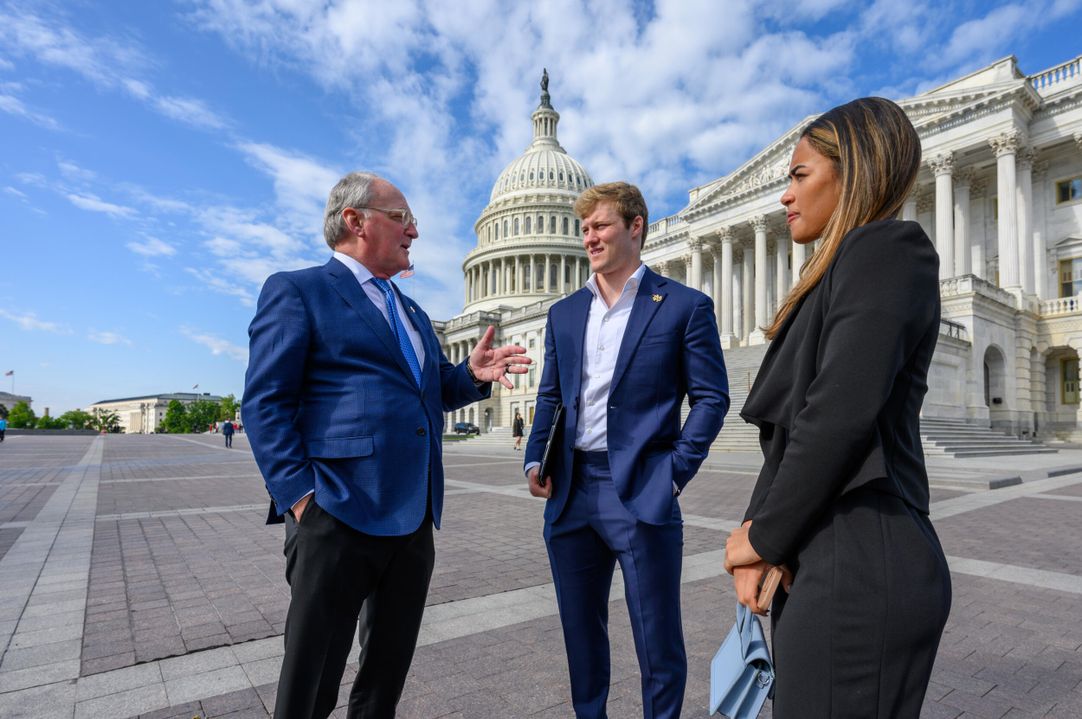
Take Campus Crossroads. Wearing his AD hat, Swarbrick wanted to modernize Notre Dame Stadium both competitively and as a revenue-producing venue, this only two decades after the university expanded the stadium by 20,000 seats.
“The stadium didn’t work,” Swarbrick said. “We had mistaken tradition, as Notre Dame frequently does, for addressing current needs.”
He recalled a senior University executive, telling him, “Whatever I did, don’t ever bring forward a proposal for premium space at the stadium because it would cost me my job.
“When you say that to me,” Swarbrick said, breaking into laughter, “it’s like, ‘Okay, I’m gonna see if I can do that.’”
Swarbrick wanted the premium space – luxury boxes, in the common parlance – not only for the revenue they produce, but to relocate the more sedate Irish fans farther from the field. “We consumed football here like theater,” Swarbrick said. “Everybody would sit, they applauded at appropriate times, and it had no energy. We took the top 25 teams over 25 years, and measured home field advantage. We were dead last. I got so tired of the visiting ADs coming up to me and saying, ‘We love playing here.’ I’m thinking to myself, ‘I don’t want you to love playing here.’”
“I got so tired of the visiting ADs coming up to me and saying, ‘We love playing here.’ I’m thinking to myself, ‘I don’t want you to love playing here.’”
The more Swarbrick thought about it, the more he realized that he had taken on a real estate puzzle. The stadium is a beloved icon in what had evolved into the middle of campus, and he thought people should have access to it more than seven times a year. So the university attached three new buildings to the stadium, it became a smashing success, and, oh, by the way, in the seven seasons that the Irish have played in the modernized, and yes, rowdier stadium, they have a record of 40-5.
“To me that project really symbolizes what he was trying to do as an athletic director,” said faculty athletic representative Patricia Bellia, O’Neill Professor of Law and Notre Dame Presidential Fellow in the Notre Dame Law School, “which is to make sure that for every student-athlete, their academic and athletic lives were integrated. They could flourish in both.”
Rev. John I. Jenkins, C.S.C., the president emeritus of the university and a fellow Class of 1976 graduate, remembered his first reaction as marveling at Swarbrick’s creativity.
“People were sort of critics starting out,” Father John said. “I don’t hear much criticism now. That’s a pretty good idea.” He referenced the famed Chicago architect Daniel Burnham, who said, “Make no little plans. They have no magic to stir men’s blood and probably will not themselves be realized.”
Big plans necessitate big thinking. A number of colleagues referred to Swarbrick as an athletic director who thought like a conference commissioner. It’s by definition a duty of the Notre Dame AD, who must make a television deal like a commissioner and serve on the College Football Playoff Management Committee with the FBS conference commissioners. “I don’t think you can ever overstate the value of carrying himself as a commissioner in a complex world of college athletics, where there’s a lot of jealousies and a lot of envy,” Brennan said.
Brennan’s reference is to the two-year battle to expand the College Football Playoff from four teams to 12. Swarbrick joined three conference commissioners on the subcommittee that created the expansion plan.
“That role is probably testament to how Jack is viewed,” said former Big 12 commissioner Bob Bowlsby, another member of the subcommittee. “I don’t ever remember anybody suggesting over the 12 years I was involved that there ought to be any sort of rotation, you know, a BYU representative ought to be there instead of Notre Dame. Everybody felt like they were very well represented by Jack. Both because of his thoughtfulness and his intellect, as ‘Switzerland,’ he was able to help us get to good places.”
“I don’t ever remember anybody suggesting over the 12 years I was involved that there ought to be any sort of rotation, you know, a BYU representative ought to be there instead of Notre Dame.”
Swarbrick midwifed the painstaking development of the plan, which took so long that the 12-team CFP is beginning one season later than originally planned. Notre Dame’s decision to accept having no access to the top four seeds – and the first-round bye that comes with them – gave Swarbrick credibility to bring the plan to fruition. Swarbrick understood the logic – conference champions would have played a 13th game and Notre Dame, without a conference championship game, stops at 12. Logic is no analgesic for the bruised pride of the Fighting Irish faithful.
“That’s what negotiation is about,” Swarbrick said. “I knew it was not going to go (over) well with our fans. But without it I don’t know that we get the 12-team playoff.”
Swarbrick acknowledges the compliment of being a commissioner in an AD’s clothing. It’s the role that fits him. “The flipside is my day-to-day management skills are marginal at best,” Swarbrick said. “I naturally think in strategic terms so I have to surround myself with people who are really good managers and don’t feel like they have to come into my office and ask me what to do.”
Baumer Family Head Men’s Lacrosse Coach Kevin Corrigan, who last month completed his 36th season at Notre Dame by winning a second consecutive national championship, may be the last guy who needs someone to come into his office and tell him what to do. Swarbrick, Corrigan said, stuck his head in Corrigan’s door once.
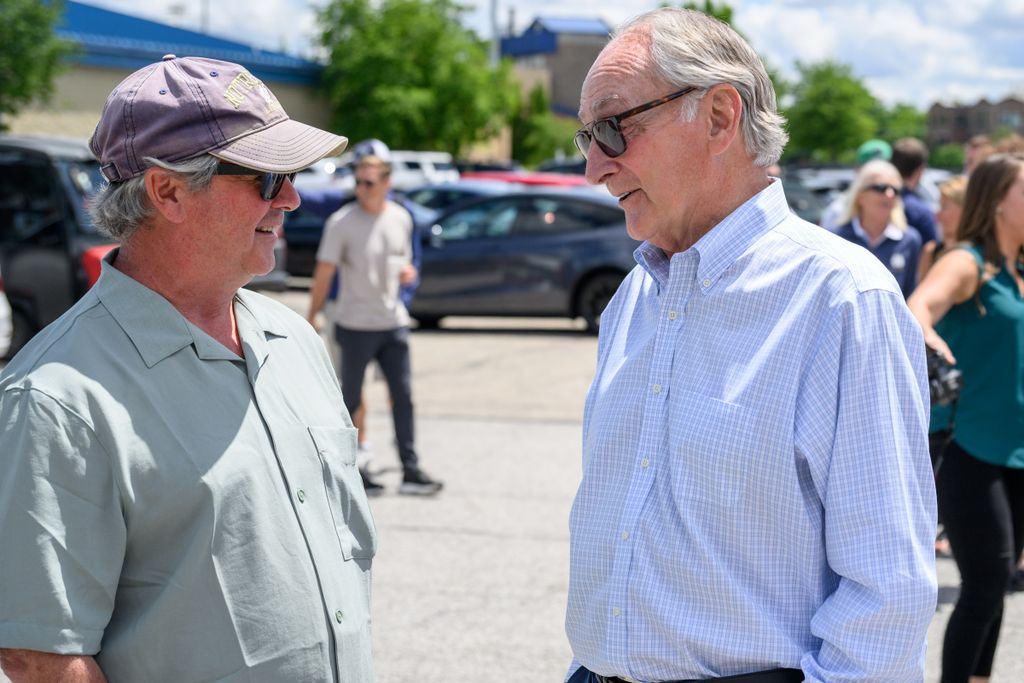
“When Jack was interacting with us,” Corrigan said, “it was more in the context of, ‘Here’s what’s coming down the road. Here’s how we’re preparing. It does or doesn’t affect you right now. I’m guiding the university and the department through it but your job is to guide your program through it.’ And to look at these things as opportunities. There might be challenges, but in every challenge is an opportunity if you can look at it the right way and figure it out.”
Senior Associate Athletics Director Aaron Horvath said that Swarbrick loved to tell the story of the time he sat next to a Fortune 500 CEO on a flight to Indianapolis.
“What’s one thing you’d give me as a leader that I could do?” Swarbrick asked.
“Every day you have 100 things to worry about,” the CEO said. “Your job is to ignore 97.”
“As a leader, you have to focus on the three most important things. But just as important, you have to let your people who you put in place worry about the other 97 things.”
His hands-off style went in both directions on the university org chart.
“Jack is not a great prompt responder, even with his boss,” Jenkins said with a smile. “You gotta press him a little bit. He does get back to you eventually.”
No news was good news. If he did respond, it often meant he disagreed with the course of action taken, and his response consisted, in total, of “Not at all what I was thinking.” Among his staff, this became a meme. Senior Associate Athletics Director Jenny Borg said it took her some time to realize that Swarbrick didn’t mean it as criticism but as mentoring.
“He’s a wonderful listener,” Borg said. “I would say he is very thoughtful and strategic about everything he does. I may come to him with one thing that I need a decision right now and he’s gonna think about the five things it will impact.”
“I may come to him with one thing that I need a decision right now and he’s gonna think about the five things it will impact.”
Put another way, Swarbrick took to heart the wisdom handed down by Greek philosopher Epictetus and everyone’s first-grade teacher – we have two ears and one mouth. “He says less than he knows,” Rev. Jenkins, Swarbrick’s fellow Class of 1976 grad, said, “and so in a way he has the ability to direct the conversation in a certain way that I actually I think that is a great skill.”
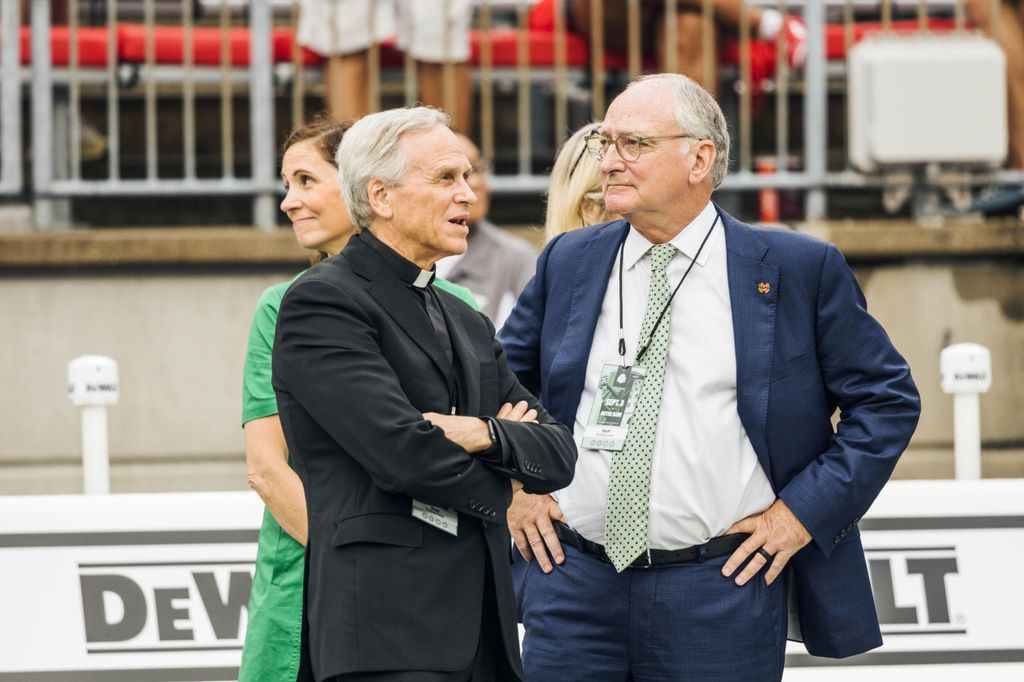
Seeing around the corner is also another way of saying that Swarbrick is an early adapter. He envisioned, early in his tenure, that media would be the key to the viability of Notre Dame’s independence. It is not news in 2024 that where ABC/ESPN, CBS, NBC and Fox spend their money determines the fate of American sports. But Swarbrick saw the importance of media when he took the job, way back in 2007, before the ubiquity of smartphones.
“The one critical decision we made early on was, we’re going to be storytellers,” Swarbrick said.
The development of Fighting Irish Media allowed Notre Dame to maintain more control over the portrayal of the university’s athletic teams, coaches, and players. “Go look at the piece we did on Jessica Harris. It’s a story of a remarkable young woman. But ask yourself, is this a sports story? Or is this a story about Notre Dame? That’s what we did, because the New York Daily News and the Chicago Tribune weren’t going to do it.”
Fighting Irish Media (FIM) has grown exponentially. It now employs 45 people, not to mention serving as an academic lab for a multitude of students interested in journalism and/or business as a career. You may see the fruits of its student worker program on your TV on any given day, with FIM counting Mike Monaco (ESPN), Jac Collinsworth (NBC Sports) and Jess Smetana (Meadowlark Media – Dan LeBatard Show) as some of its many recent front-of-camera successes.
Nowhere has Swarbrick’s decision to bet on media been more fruitful than the university’s 33-year partnership with NBC. The university’s teams have been shown on NBC, USA, the late NBC Sports Network, and now, Peacock. Notre Dame’s debut on the latter perfectly illustrates Swarbrick’s desire to employ media to further the university’s aims.
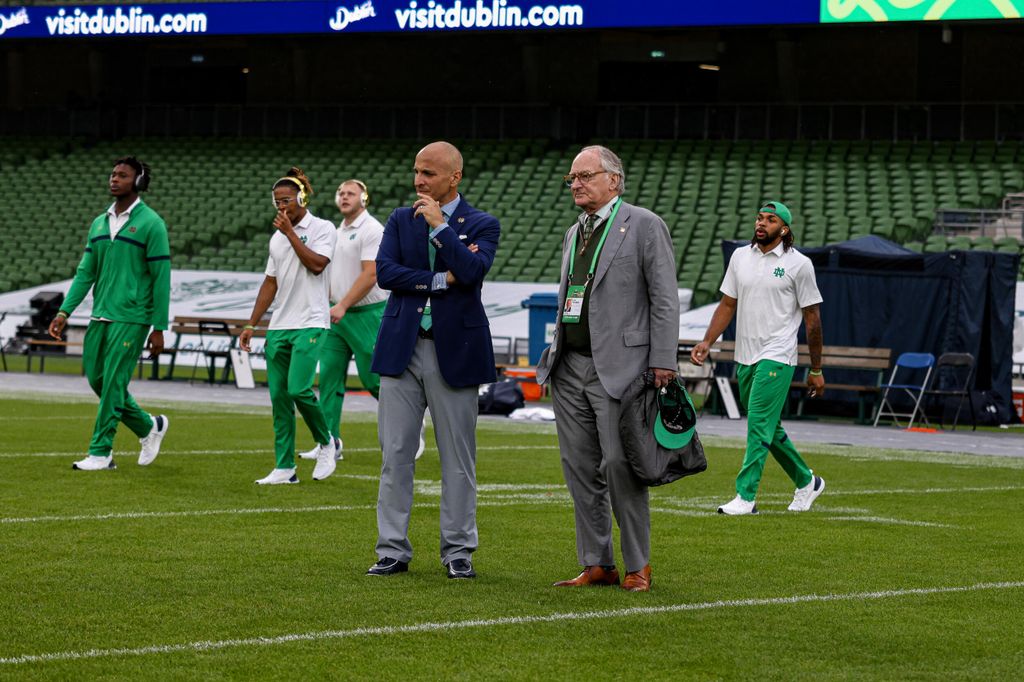
Three years ago, Bevacqua, then the chairman of NBC Sports, brought a delegation to Notre Dame to meet with Swarbrick. At the top of Bevacqua’s wish list: that the Fighting Irish would agree to have a 2021 football game shown on Peacock, the company’s one-year-old streaming service.
“I remember on the plane ride out,” said Bevacqua, now ensconced in his office in the Joyce Athletic and Convocation Center, “we were preparing our approach and what we would do when Jack said no, because he had to say no. You know, ‘Too risky, we only have a handful of home games, these are sacred.’”
They had their meeting, with Bevacqua waiting to casually drop his question, as if asking Notre Dame to appear on a streaming service that had little name recognition was no big deal.
“Then,” Bevacqua said, “remember Columbo always came back in the room at the end to say, ‘One more thing?’ I remember saying, ‘Jack, we have one more thing we want to talk about. And we say, ‘Hey, we’d like to take one home game and put it exclusively on Peacock.’
“And almost instantaneously Jack said, ‘I love that. Let’s do it. I want to make sure Notre Dame is first, gets ahead of this. More and more media is going to head there. We want to be a leader not a follower.”
“We were a little thrown off,” Bevacqua said, grinning. “We had a whole round of arguments ready to go. ‘Here’s why we should.’ ‘Yeah, I hear you Jack. Just hear us out.’ I always loved that about Jack. He was willing to do things differently. Take some chances.”
“And almost instantaneously Jack said, ‘I love that. Let’s do it. I want to make sure Notre Dame is first, gets ahead of this. More and more media is going to head there. We want to be a leader not a follower.”
Rob Hyland, the coordinating producer of Sunday Night Football and the producer of the NBC’s primetime Olympic coverage, said that the network tested tools such as HDR (High Dynamic Range) video and Dolby Atmos Audio on Fighting Irish telecasts. Showing behind-the-scenes events which the audience has never seen before has become a staple.
“Jack always encouraged access to help showcase the teaching aspect of coaching,” Hyland said in an email.
Swarbrick’s record of hiring coaches is not only strong as judged by wins and losses, but noteworthy for its lack of uniformity. Glenn & Stacey Murphy Head Men’s Basketball Coach Micah Shrewsberry had a long resume in college and professional basketball and came from Penn State. Baseball’s Shawn Stiffler came to Notre Dame after 10 years as head coach at Virginia Commonwealth. Dick Corbett Head Football Coach Marcus Freeman and Karen & Kevin Keyes Head Women’s Basketball Coach Niele Ivey had no head coaching experience.
“He watched me because I was an assistant for 12 years under Coach (Muffet) McGraw,” Ivey said, “so I feel he saw my work ethic. He saw my passion and the things I did that aligned with the core values of Notre Dame. Taking over this type of Power Five job, I had to have all the tools, all the intangibles, everything that a coach needs to be able to be successful here. And he saw that in me.”
Women’s volleyball coach Salima Rockwell, also never a head coach, had been in the broadcast booth for three years.
“Everyone that’s been here, everyone that I’ve met, has believed so much in Jack’s leadership and his vision and his ability to stay ahead of the curve,” Rockwell said. “He’s brilliant, you know, like we all know that.”
She didn’t say, “Duh.’ But it was implied.
“He’s got so much wisdom,” Ivey said. “That’s so valuable. I’m gonna miss that.”
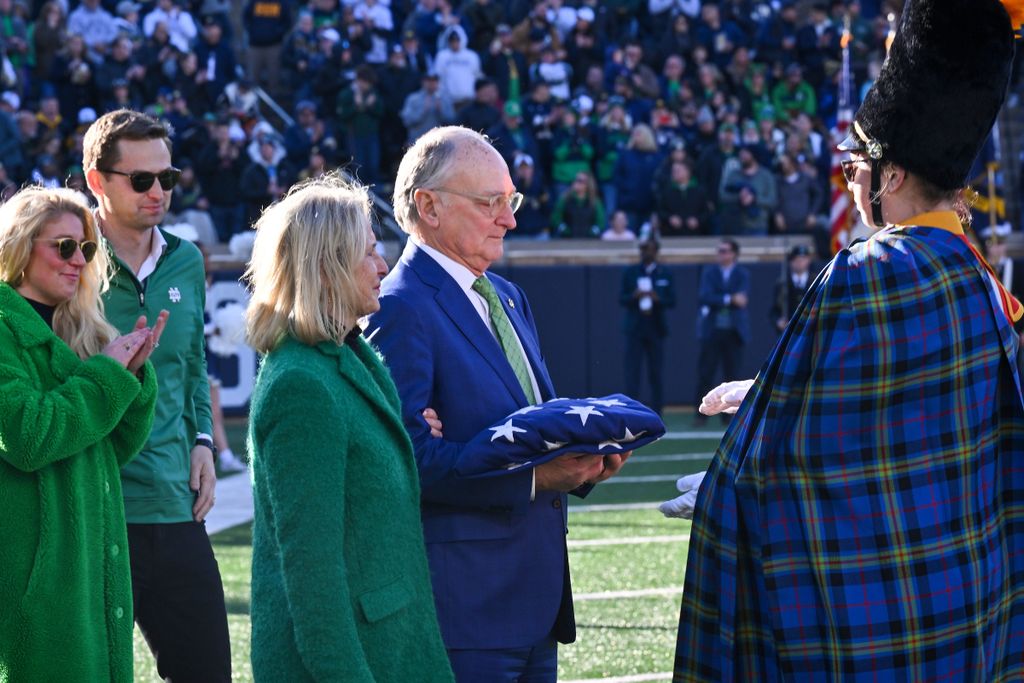
Swarbrick will be missed when he goes home to Indianapolis. His staff will miss hearing Swarbrick nerd out on music. Swarbrick enlivened the drudgery of the COVID Era by beginning each Zoom staff meeting with a song and a quote to emphasize his theme. A gold record of the Swarbrick Sessions hangs on his office wall.
The staff will miss hearing, “Not at all what I was thinking.” And they will be hearing his stock response when asked, “How are you?”
“Couldn’t be better,” Swarbrick replied. That serves as a performance review of his time beneath the Golden Dome.
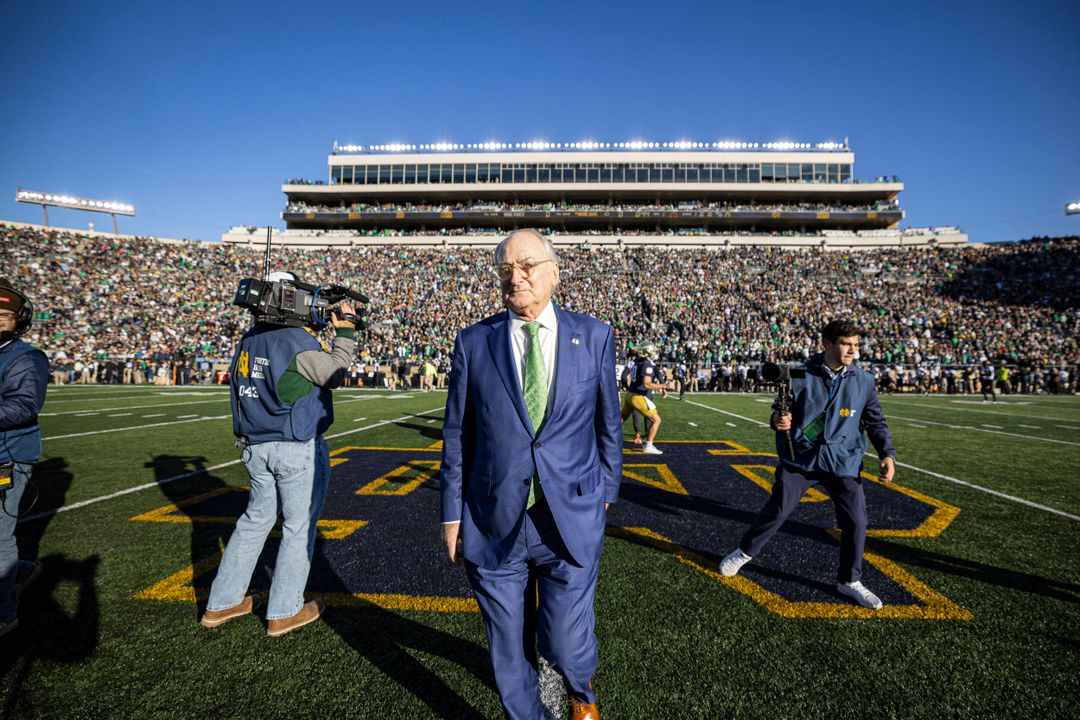
Ivan Maisel started covering college football in 1981 and has worked for the Atlanta-Journal Constitution, the Dallas Morning News, Newsday, Sports Illustrated, ESPN and On3.com. He was the first college football writer hired by ESPN.com and for many years hosted the ESPN college football podcast with the late Beano Cook and other ESPN colleagues.







